Photovoltaic Solar Electro-Oxidation (PSEO) Process For Wastewater Treatment
Photovoltaic Solar Electro-Oxidation (PSEO) Process For Wastewater Treatment
Source: https://www.elsevier.com
Author: Enrique Alvarez-Guerra, Antonio Dominguez-Ramos, Angel Irabien
Usually dispatched in 2 to 3 days
Usually dispatched in 2 to 3 days
Category:
Researches
Electro-oxidation with boron-doped diamond (BDD) electrodes has been demonstrated as an effective technology that achieves the complete mineralization of very different types of wastewater pollutants. Its main drawback is the high primary energy demand.
Only logged in customers who have purchased this product may leave a review.
Related products
A Review of Reverse Osmosis Membrane Fouling and Control Strategies
Introduction
This paper reviews membrane contamination and dirt Control strategies, focusing on the latest developments.
The first goal From this paper is to illustrate the types of dirt.
The second goal is To discuss the latest pollution mitigation strategies, including pre-treatment, monitoring, cleaning, and surface modification as well as updates.
A Review of Reverse Osmosis Membrane Fouling and Control Strategies
Introduction
This paper reviews membrane contamination and dirt Control strategies, focusing on the latest developments.
The first goal From this paper is to illustrate the types of dirt.
The second goal is To discuss the latest pollution mitigation strategies, including pre-treatment, monitoring, cleaning, and surface modification as well as updates.
Correlation Between BOD5 and COD for Al- Diwaniyah Wastewater Treatment Plants to Obtain The Biodigrability Indices
ABSTRACT
The present study aims to establish an empirical correlation between biochemical oxygen demand (BOD5) and chemical oxygen demand (COD) of the sewage flowing in Al-Diwaniyah wastewater treatment plant. The strength of the wastewater entering the plant varied from medium to high. High concentrations of BOD5 and COD in the effluent were obtained due to the poor performance of the plant. This was observed from the BOD5 /COD ratios that did not confirm with the typical ratios for the treated sewage. Regression equations for BOD5 and COD removal percentages were suggested which can be used to evaluate rapid effluent assessment after the treatment processes or optimal process control to improve the performance of wastewater treatment plants. The average Biodegradability indices (B.I) of Al-Diwaniyah wastewater plants was found to be 0.69. The equations relating the percentage removal of BOD5(y) with influent BOD5(x), y= 0.044x + 80.66 and the percentage removal of COD (y) with influent COD (x), y= 0.045x + 55.15 were found with high correlation R2 =0.72 and 0.86 respectively. Keywords: BOD5, COD, BOD5/COD ratio, Biodegradability indices, BOD5 and COD correlations
Correlation Between BOD5 and COD for Al- Diwaniyah Wastewater Treatment Plants to Obtain The Biodigrability Indices
ABSTRACT
The present study aims to establish an empirical correlation between biochemical oxygen demand (BOD5) and chemical oxygen demand (COD) of the sewage flowing in Al-Diwaniyah wastewater treatment plant. The strength of the wastewater entering the plant varied from medium to high. High concentrations of BOD5 and COD in the effluent were obtained due to the poor performance of the plant. This was observed from the BOD5 /COD ratios that did not confirm with the typical ratios for the treated sewage. Regression equations for BOD5 and COD removal percentages were suggested which can be used to evaluate rapid effluent assessment after the treatment processes or optimal process control to improve the performance of wastewater treatment plants. The average Biodegradability indices (B.I) of Al-Diwaniyah wastewater plants was found to be 0.69. The equations relating the percentage removal of BOD5(y) with influent BOD5(x), y= 0.044x + 80.66 and the percentage removal of COD (y) with influent COD (x), y= 0.045x + 55.15 were found with high correlation R2 =0.72 and 0.86 respectively. Keywords: BOD5, COD, BOD5/COD ratio, Biodegradability indices, BOD5 and COD correlations
Perspectives And Applications Of Nanotechnology In Water Treatment
Abstract
Industrialization and excessive use of pesticides for boosting agricultural production have adversely affected the ecosystem, polluting natural water reserves. Remediation of contaminated water has been an area of concern with numerous techniques being applied to improve the quality of naturally available water to the level suitable for human consumption. Most of these methods, however, generate by-products that are sometimes toxic. Heterogenous photocatalysis using metal oxide nanostructures for water purification is an attractive option because no harmful by-products are created. A discussion on possible methods to engineer metal oxides for visible light photocatalysis is included to highlight the use of solar energy for water purification. Multifunctional photocatalytic membranes are considered advantageous over freely suspended nanoparticles due to the ease of its removal from the purified water. An overview of water remediation techniques is presented, highlighting innovations through nanotechnology for possible addressing of problems associated with current techniques.
Perspectives And Applications Of Nanotechnology In Water Treatment
Abstract
Industrialization and excessive use of pesticides for boosting agricultural production have adversely affected the ecosystem, polluting natural water reserves. Remediation of contaminated water has been an area of concern with numerous techniques being applied to improve the quality of naturally available water to the level suitable for human consumption. Most of these methods, however, generate by-products that are sometimes toxic. Heterogenous photocatalysis using metal oxide nanostructures for water purification is an attractive option because no harmful by-products are created. A discussion on possible methods to engineer metal oxides for visible light photocatalysis is included to highlight the use of solar energy for water purification. Multifunctional photocatalytic membranes are considered advantageous over freely suspended nanoparticles due to the ease of its removal from the purified water. An overview of water remediation techniques is presented, highlighting innovations through nanotechnology for possible addressing of problems associated with current techniques.
Correlating BOD5 and COD of Sewage in Wastewater Treatment Plants Case Study Al- Diwaniyah WWTP in Iraq
ABSTRACT
This study aims to establish an empirical correlation between biochemical oxygen demand (BOD5) and chemical oxygen demand (COD) of the sewage flowing in Al-Diwaniyah wastewater treatment plant. The strength of the wastewater entering the plant varied from medium to high. High concentrations of BOD5 and COD in the effluent were obtained due to the poor performance of the plant. This was observed from the BOD5 /COD ratios that did not confirm with the typical ratios for the treated sewage. To improve the performance of this plant, regression equations for BOD5 and COD removal percentages were suggested which can be used to facilitate rapid effluent assessment or optimal process control. The equations relating the percentage removal of BOD5(y) with influent BOD5(x), y= 0.044x + 80.66 and the percentage removal of COD (y) with influent COD (x), y= 0.045x + 55.15 were found with high correlation R2 =0.72 and 0.86 respectively. Key words: Sewage treatment, BOD5, COD, BOD5/COD ratio, BOD5&COD correlations
Correlating BOD5 and COD of Sewage in Wastewater Treatment Plants Case Study Al- Diwaniyah WWTP in Iraq
ABSTRACT
This study aims to establish an empirical correlation between biochemical oxygen demand (BOD5) and chemical oxygen demand (COD) of the sewage flowing in Al-Diwaniyah wastewater treatment plant. The strength of the wastewater entering the plant varied from medium to high. High concentrations of BOD5 and COD in the effluent were obtained due to the poor performance of the plant. This was observed from the BOD5 /COD ratios that did not confirm with the typical ratios for the treated sewage. To improve the performance of this plant, regression equations for BOD5 and COD removal percentages were suggested which can be used to facilitate rapid effluent assessment or optimal process control. The equations relating the percentage removal of BOD5(y) with influent BOD5(x), y= 0.044x + 80.66 and the percentage removal of COD (y) with influent COD (x), y= 0.045x + 55.15 were found with high correlation R2 =0.72 and 0.86 respectively. Key words: Sewage treatment, BOD5, COD, BOD5/COD ratio, BOD5&COD correlations
Artificial Neural Network Model for the Prediction of Groundwater Quality
The present article delves into the examination of groundwater quality, based on WQI, for drinking purposes in Baghdad City. Further, for carrying out the investigation, the data was collected from the Ministry of Water Resources of Baghdad, which represents water samples drawn from 114 wells in Al-Karkh and Al-Rusafa sides of Baghdad city. With the aim of further determining WQI, four water parameters such as (i) pH, (ii) Chloride (Cl), (iii) Sulfate (SO4), and (iv) Total dissolved solids (TDS), were taken into consideration. Additionally, to anticipate changes in groundwater WQI, IBM® SPSS® Statistics 19 software (SPSS) was used to develop an artificial neural network model (ANNM). With the application of this ANNM model, the results obtained illustrated high prediction efficiency, as the sum of squares error functions (for training and testing samples) and coefficient of determination (R2), were found to be (0.038 and 0.005) and 0.973, respectively.
Artificial Neural Network Model for the Prediction of Groundwater Quality
The present article delves into the examination of groundwater quality, based on WQI, for drinking purposes in Baghdad City. Further, for carrying out the investigation, the data was collected from the Ministry of Water Resources of Baghdad, which represents water samples drawn from 114 wells in Al-Karkh and Al-Rusafa sides of Baghdad city. With the aim of further determining WQI, four water parameters such as (i) pH, (ii) Chloride (Cl), (iii) Sulfate (SO4), and (iv) Total dissolved solids (TDS), were taken into consideration. Additionally, to anticipate changes in groundwater WQI, IBM® SPSS® Statistics 19 software (SPSS) was used to develop an artificial neural network model (ANNM). With the application of this ANNM model, the results obtained illustrated high prediction efficiency, as the sum of squares error functions (for training and testing samples) and coefficient of determination (R2), were found to be (0.038 and 0.005) and 0.973, respectively.
Fouling and Cleaning Characteristics of Reverse Osmosis (RO) Membranes
Abstract:
This work deals with fouling and successive cleaning of RO membrane fouled by an organic foulant, sodium alginate using a laboratory-scale cross flow test unit. First, spiral-wound RO membrane was fouled with sodium alginate solution up to 10% and 15%, respectively at an applied pressure of 1380 kPa with flow rate of 10 lit/min. An anionic surfactant, sodium dodecyl sulfate (SDS) was used as a chemical cleaning agent for cleaning of RO membrane. The effect of cleaning chemical dose and cross-flow velocity on the membrane chemical cleaning duration to achieve 100% cleaning efficiency (i.e., to get original water flux) was also investigated. As the SDS concentration increases, the membrane chemical cleaning time decreases due to increase in the solubility of the foulant (when the surface tension decreases by an increase in the SDS concentration). Furthermore, the membrane chemical cleaning time decreases with increasing cross-flow velocity of the cleaning chemical solution (SDS). Higher cross-flow velocity enhances the turbulence at the fouling layer and hence the mass transfer of the foulant from the fouling layer to the bulk solution is improved, then the SDS has weakened the structural integrity of the fouling layer. It is observed that better cleaning is occurred with higher concentration of SDS and flow rate. The obtained results clearly reveal that SDS cleaning is proved to be an efficient cleaning method for RO membranes fouled with organic foulant.
Fouling and Cleaning Characteristics of Reverse Osmosis (RO) Membranes
Abstract:
This work deals with fouling and successive cleaning of RO membrane fouled by an organic foulant, sodium alginate using a laboratory-scale cross flow test unit. First, spiral-wound RO membrane was fouled with sodium alginate solution up to 10% and 15%, respectively at an applied pressure of 1380 kPa with flow rate of 10 lit/min. An anionic surfactant, sodium dodecyl sulfate (SDS) was used as a chemical cleaning agent for cleaning of RO membrane. The effect of cleaning chemical dose and cross-flow velocity on the membrane chemical cleaning duration to achieve 100% cleaning efficiency (i.e., to get original water flux) was also investigated. As the SDS concentration increases, the membrane chemical cleaning time decreases due to increase in the solubility of the foulant (when the surface tension decreases by an increase in the SDS concentration). Furthermore, the membrane chemical cleaning time decreases with increasing cross-flow velocity of the cleaning chemical solution (SDS). Higher cross-flow velocity enhances the turbulence at the fouling layer and hence the mass transfer of the foulant from the fouling layer to the bulk solution is improved, then the SDS has weakened the structural integrity of the fouling layer. It is observed that better cleaning is occurred with higher concentration of SDS and flow rate. The obtained results clearly reveal that SDS cleaning is proved to be an efficient cleaning method for RO membranes fouled with organic foulant.
Adsorption of Heavy Metal Ions from Aqueous Solutions onto Rice Husk Ash Low Cost Adsorbent
Abstract
In the present study, adsorption of Zn (II), Cd (II) and Hg (II) ions on rice husk ash (RHA) has been investigated in single, binary and tertiary systems.
Batch experiments were also carried out for mono-and multi-component systems with varying metal ions concentrations (mg/l) to investigate the competitive adsorption characteristics.
Adsorption of Heavy Metal Ions from Aqueous Solutions onto Rice Husk Ash Low Cost Adsorbent
Abstract
In the present study, adsorption of Zn (II), Cd (II) and Hg (II) ions on rice husk ash (RHA) has been investigated in single, binary and tertiary systems.
Batch experiments were also carried out for mono-and multi-component systems with varying metal ions concentrations (mg/l) to investigate the competitive adsorption characteristics.
Nanotechnology in Water Treatment
ABSTRACT Drinking water is unfortunately becoming a rare luxury on our planet.On the other hand, with a trend of population growth, need for water which is essential to life,is becomingbigger every day.Practical application of nanotechnology in saving water worldwide is in using nanoparticles in detection of water pollution and water purification. This knowledge has importance in medicine and public health, so as in environment safety.Possible application areas of nanotechnology in field of purification and treatment of water are in filtration, catalytic and separation processes, ion exchanging, sensitive pollutant detection,etc.Nanotechnology could be the main solution in future fortreatment of surface water,groundwater, and waste water contaminated by toxic metal ions, organic and inorganic solutes, and microorganisms.
Nanotechnology in Water Treatment
ABSTRACT Drinking water is unfortunately becoming a rare luxury on our planet.On the other hand, with a trend of population growth, need for water which is essential to life,is becomingbigger every day.Practical application of nanotechnology in saving water worldwide is in using nanoparticles in detection of water pollution and water purification. This knowledge has importance in medicine and public health, so as in environment safety.Possible application areas of nanotechnology in field of purification and treatment of water are in filtration, catalytic and separation processes, ion exchanging, sensitive pollutant detection,etc.Nanotechnology could be the main solution in future fortreatment of surface water,groundwater, and waste water contaminated by toxic metal ions, organic and inorganic solutes, and microorganisms.
A Pilot Study of an Electromagnetic Field for Control of Reverse Osmosis Membrane Fouling and Scaling During Brackish Groundwater Desalination
Abstract: This study investigated the effects of an electromagnetic field (EMF) on control of membrane
fouling and scaling during desalination of brackish groundwater using a pilot reverse osmosis (RO)
skid. The groundwater was primarily CaSO4 type with a total dissolved solids concentration of
5850 mg/L and hardness of 2500 mg/L as CaCO3. Two EMF devices were installed in the pipeline
before a cartridge filter and in the RO feed inlet to induce an electric signal of ±150 kHz to the
groundwater. The effects of EMF on membrane scaling were evaluated under accelerated conditions,
i.e., without pH adjustment and addition of antiscalant. Two-phase experiments were conducted:
Phase 1 (376 h) with the EMF devices turned on after 150 h baseline operation; and Phase 2 (753 h)
with the EMF devices turned on from the beginning of testing. The EMF significantly reduced
membrane scaling and improved RO performance by 38.3% and 14.3% in terms of normalized water
permeability decline rate after 150 h and 370 h operation, respectively. Membrane autopsy results
indicated that the fouling layer formed under the influence of EMF was loose with a low density and
was easily removed by hydraulic flushing
A Pilot Study of an Electromagnetic Field for Control of Reverse Osmosis Membrane Fouling and Scaling During Brackish Groundwater Desalination
Abstract: This study investigated the effects of an electromagnetic field (EMF) on control of membrane
fouling and scaling during desalination of brackish groundwater using a pilot reverse osmosis (RO)
skid. The groundwater was primarily CaSO4 type with a total dissolved solids concentration of
5850 mg/L and hardness of 2500 mg/L as CaCO3. Two EMF devices were installed in the pipeline
before a cartridge filter and in the RO feed inlet to induce an electric signal of ±150 kHz to the
groundwater. The effects of EMF on membrane scaling were evaluated under accelerated conditions,
i.e., without pH adjustment and addition of antiscalant. Two-phase experiments were conducted:
Phase 1 (376 h) with the EMF devices turned on after 150 h baseline operation; and Phase 2 (753 h)
with the EMF devices turned on from the beginning of testing. The EMF significantly reduced
membrane scaling and improved RO performance by 38.3% and 14.3% in terms of normalized water
permeability decline rate after 150 h and 370 h operation, respectively. Membrane autopsy results
indicated that the fouling layer formed under the influence of EMF was loose with a low density and
was easily removed by hydraulic flushing
Calibration And Verification Of The Hydraulic Model For Blue Nile River from Roseries Dam To Khartoum City
ABSTRACT:
This research represents a practical attempt applied to calibrate and verify a hydraulic model for the Blue Nile River. The calibration procedures are performed using the observed data for a previous period and comparing them with the calibration results while verification requirements are achieved with the application of the observed data for another future period and comparing them with the verification results. The study objective covered a relationship of the river terrain with the distance between the assumed points of the dam failures along the river length. The computed model values and the observed data should conform to the theoretical analysis and the overall verification performance of the model by comparing it with another set of data. The model was calibrated using data from gauging stations (Khartoum, Wad Medani, downstream Sennar, and downstream Roseires) during the period from the 1st of May to 31 of October 1988 and the verification was done using the data of the same gauging stations for years 2003 and 2010 for the same period. The required available data from these stations were collected, processed and used in the model calibration. The geometry input files for the HEC-RAS models were created using a combination of ArcGIS and HEC-GeoRAS. The results revealed high correlation (R2 ˃ 0.9) between the observed and calibrated water levels in all gauging stations during 1988 and also high correlation between the observed and verification water levels was obtained in years 2003 and 2010. Verification results with the equation and degree of correlation can be used to predict future data of any expected data for the same stations.
Calibration And Verification Of The Hydraulic Model For Blue Nile River from Roseries Dam To Khartoum City
ABSTRACT:
This research represents a practical attempt applied to calibrate and verify a hydraulic model for the Blue Nile River. The calibration procedures are performed using the observed data for a previous period and comparing them with the calibration results while verification requirements are achieved with the application of the observed data for another future period and comparing them with the verification results. The study objective covered a relationship of the river terrain with the distance between the assumed points of the dam failures along the river length. The computed model values and the observed data should conform to the theoretical analysis and the overall verification performance of the model by comparing it with another set of data. The model was calibrated using data from gauging stations (Khartoum, Wad Medani, downstream Sennar, and downstream Roseires) during the period from the 1st of May to 31 of October 1988 and the verification was done using the data of the same gauging stations for years 2003 and 2010 for the same period. The required available data from these stations were collected, processed and used in the model calibration. The geometry input files for the HEC-RAS models were created using a combination of ArcGIS and HEC-GeoRAS. The results revealed high correlation (R2 ˃ 0.9) between the observed and calibrated water levels in all gauging stations during 1988 and also high correlation between the observed and verification water levels was obtained in years 2003 and 2010. Verification results with the equation and degree of correlation can be used to predict future data of any expected data for the same stations.
Emerging desalination technologies for water treatment: A critical review
Abstract:
In this paper, a review of emerging desalination technologies is presented. Several technologies for desalination of municipal and industrial wastewater have been proposed and evaluated, but only certain technologies have been commercialized or are close to commercialization. This review consists of membrane-based, thermal-based and alternative technologies. Membranes based on incorporation of nanoparticles, carbon nanotubes or graphene-based ones show promise as innovative desalination technologies with superior performance in terms of water permeability and salt rejection. However, only nanocomposite membranes have been commercialized while others are still under fundamental developmental stages. Among the thermal-based technologies, membrane
distillation and adsorption desalination show the most promise for enhanced performance with the availability of a waste heat source. Several alternative technologies have also been developed recently; those based on capacitive deionization have shown considerable improvements in their salt removal capacity and feed water recovery. In the same category, microbial desalination cells have been shown to desalinate high salinity water without any external energy source, but to date, scale up of the process has not been methodically evaluated. In this paper, advantages and drawbacks of each technology is discussed along with a comparison of performance, water quality and energy consumption.
Emerging desalination technologies for water treatment: A critical review
Abstract:
In this paper, a review of emerging desalination technologies is presented. Several technologies for desalination of municipal and industrial wastewater have been proposed and evaluated, but only certain technologies have been commercialized or are close to commercialization. This review consists of membrane-based, thermal-based and alternative technologies. Membranes based on incorporation of nanoparticles, carbon nanotubes or graphene-based ones show promise as innovative desalination technologies with superior performance in terms of water permeability and salt rejection. However, only nanocomposite membranes have been commercialized while others are still under fundamental developmental stages. Among the thermal-based technologies, membrane
distillation and adsorption desalination show the most promise for enhanced performance with the availability of a waste heat source. Several alternative technologies have also been developed recently; those based on capacitive deionization have shown considerable improvements in their salt removal capacity and feed water recovery. In the same category, microbial desalination cells have been shown to desalinate high salinity water without any external energy source, but to date, scale up of the process has not been methodically evaluated. In this paper, advantages and drawbacks of each technology is discussed along with a comparison of performance, water quality and energy consumption.



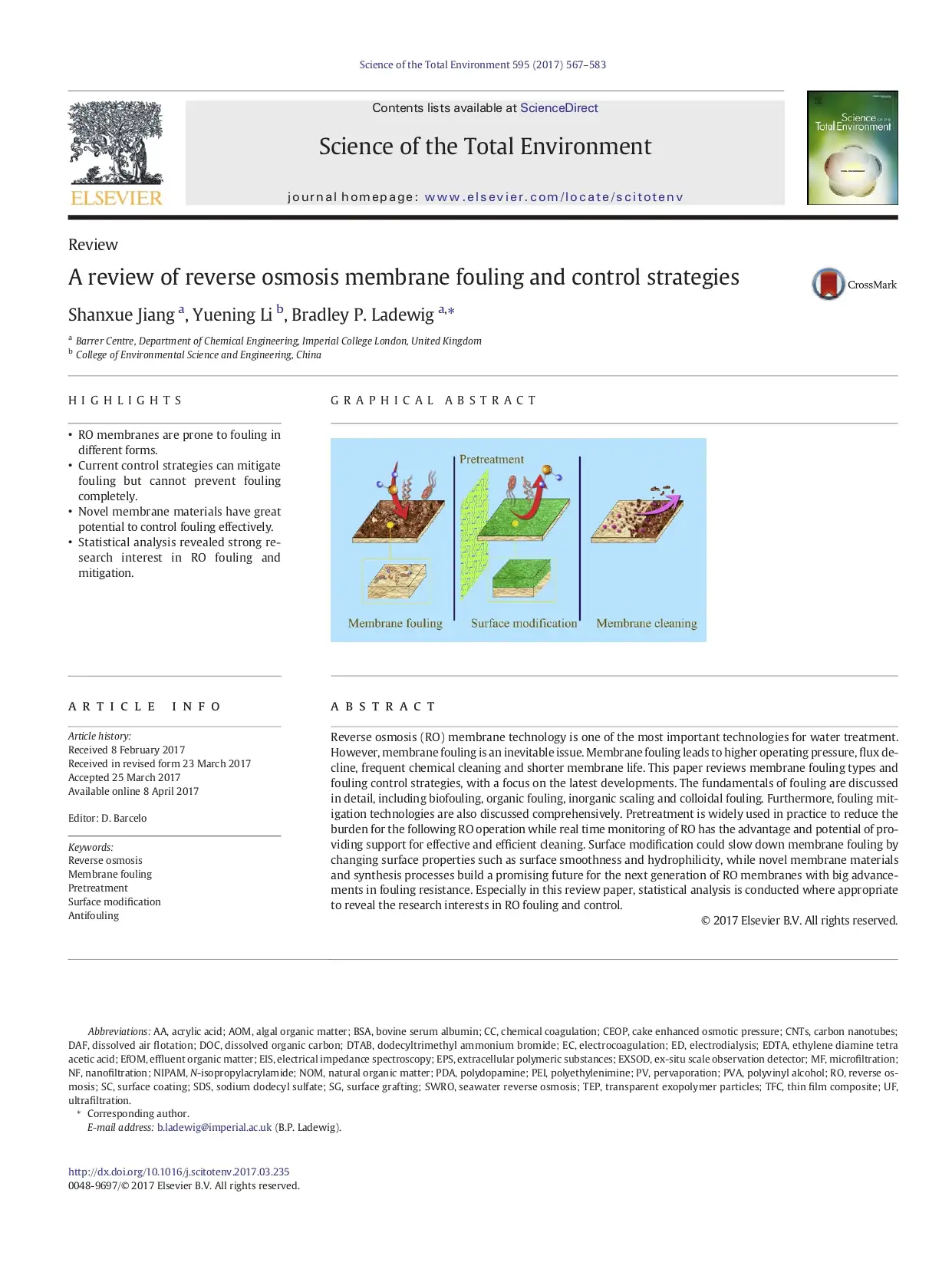
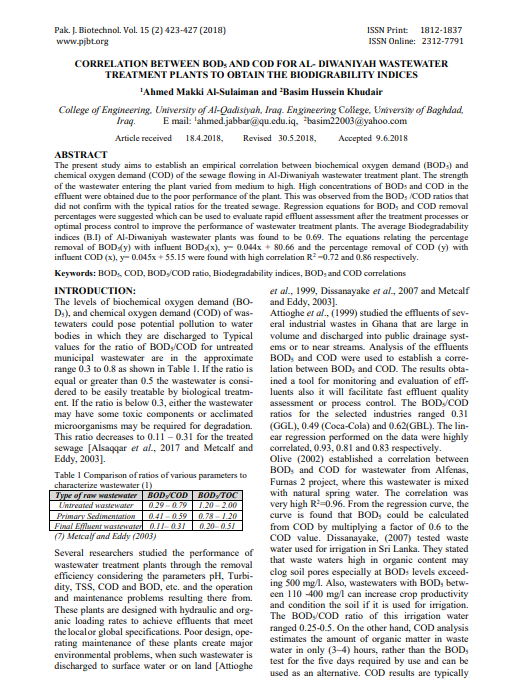
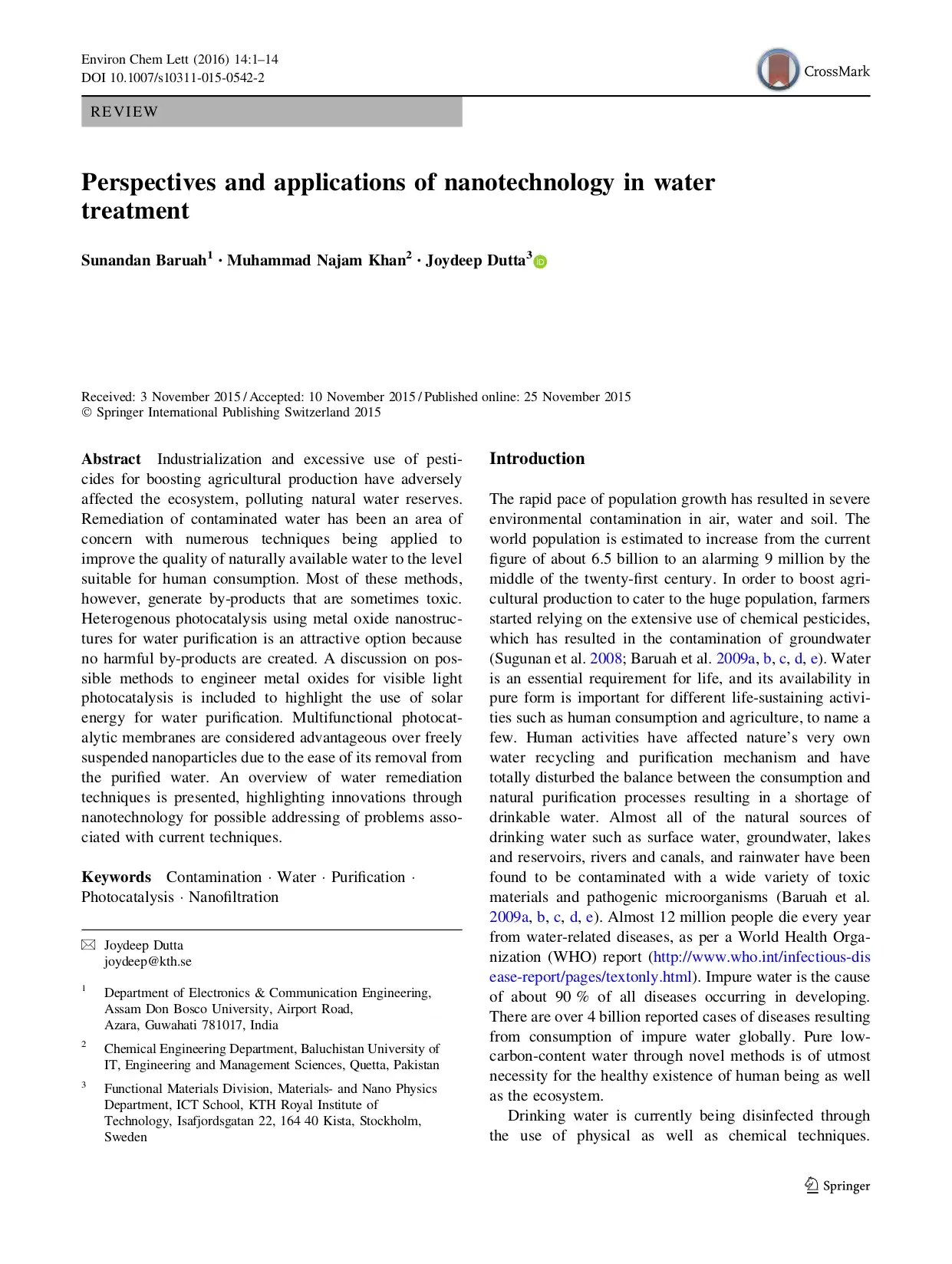

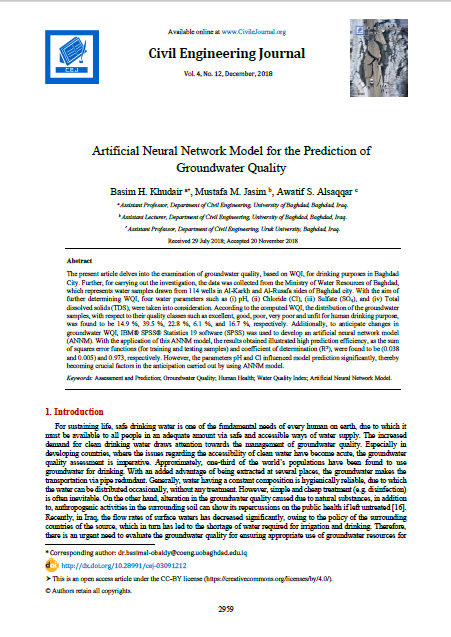
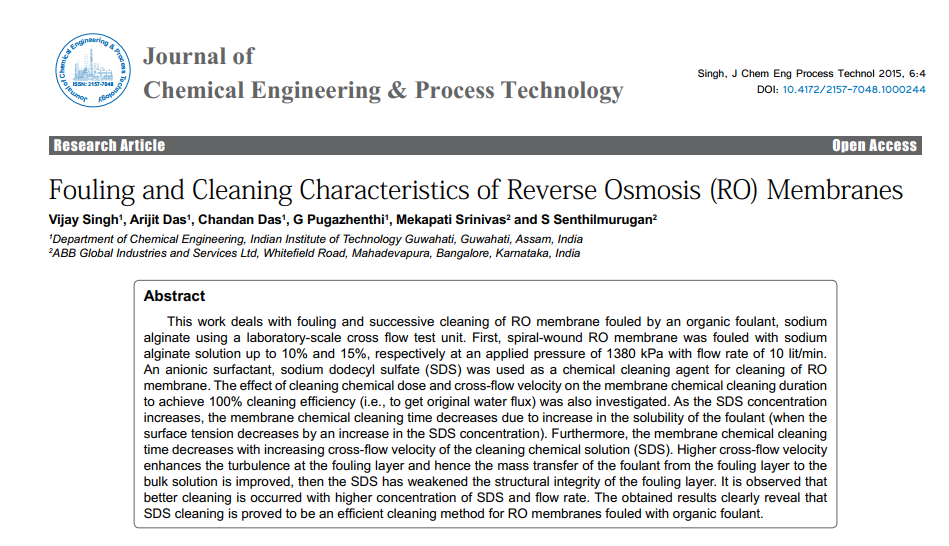
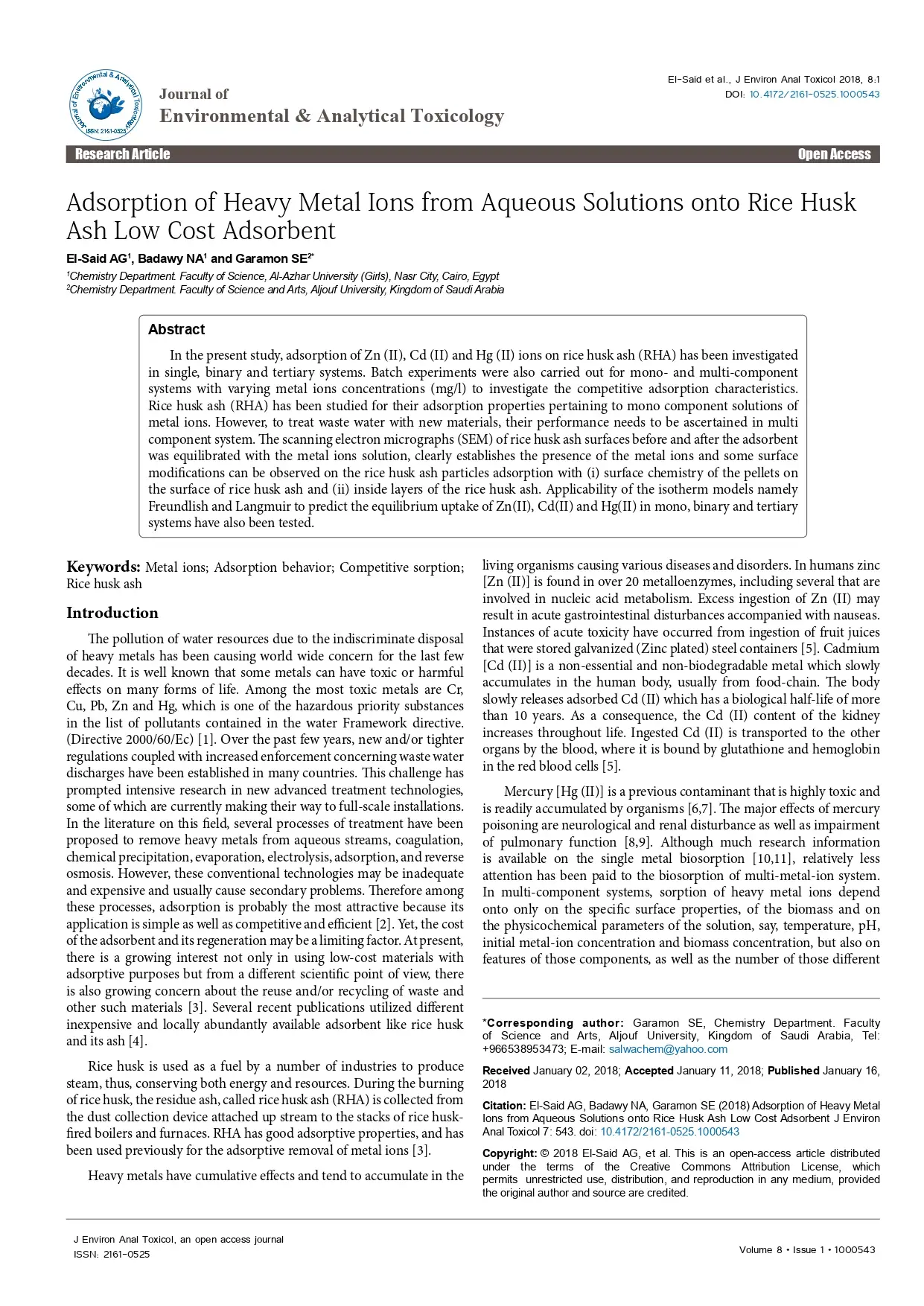
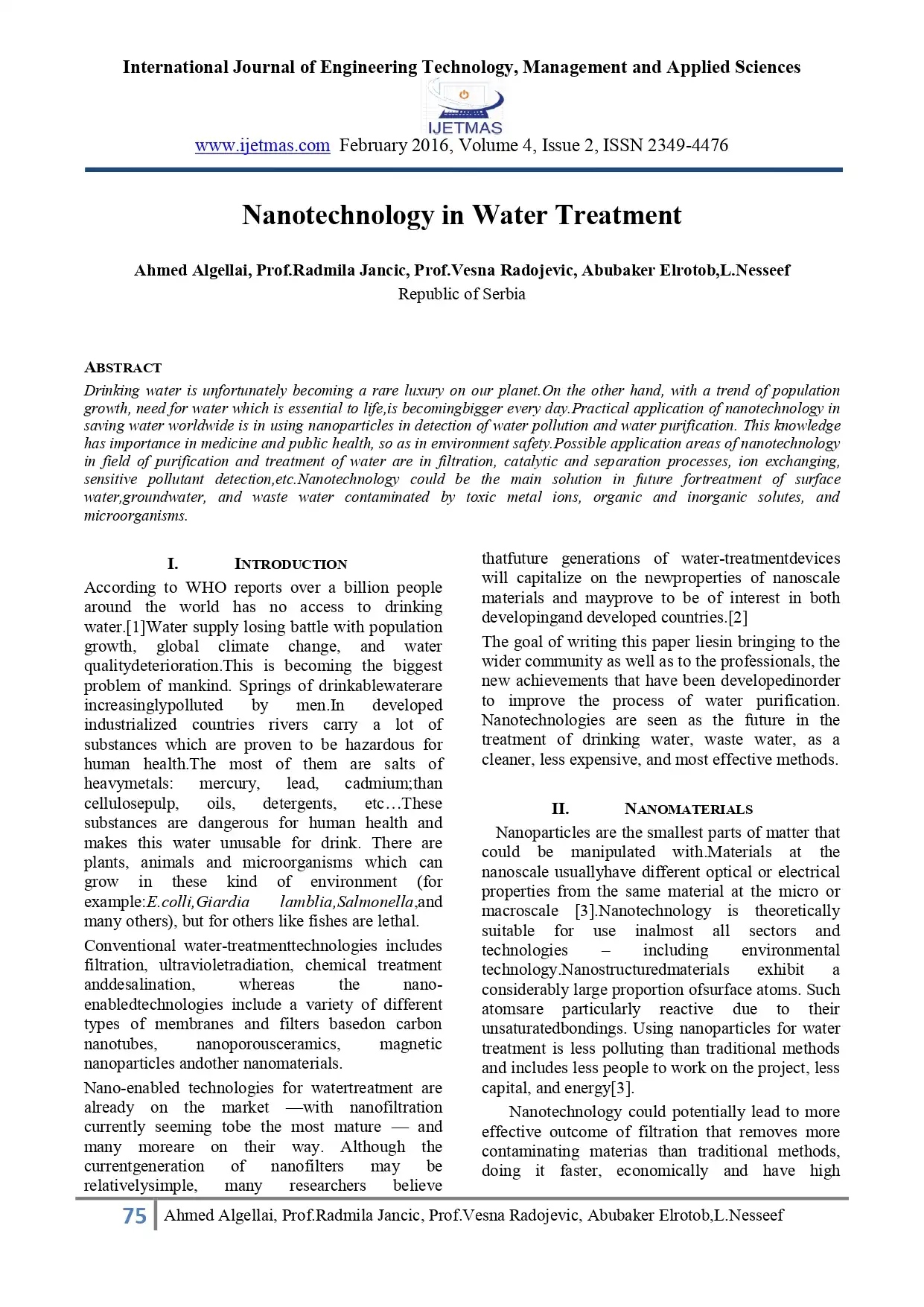
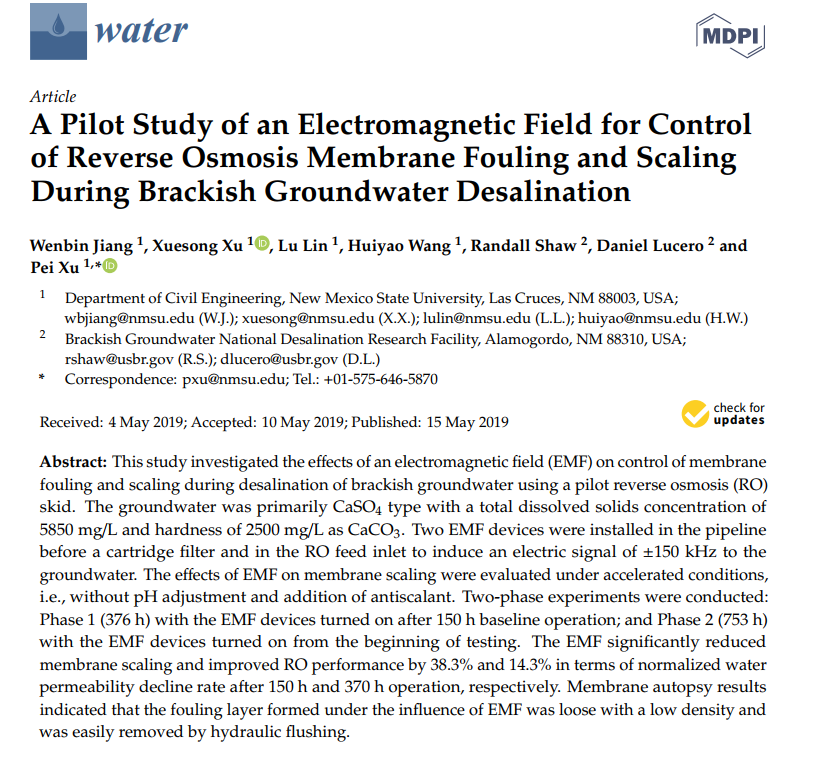
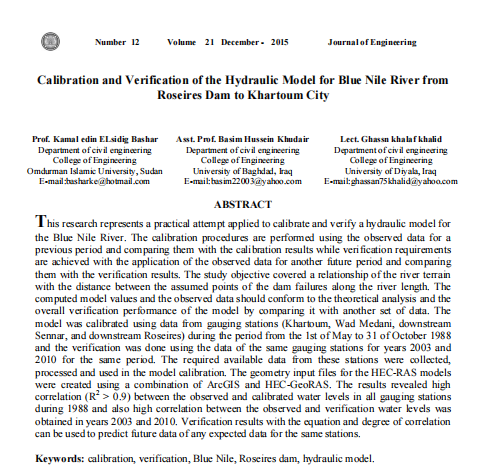
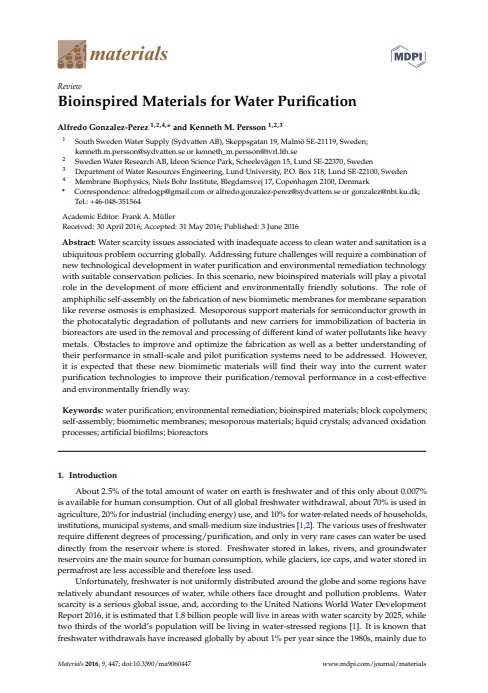
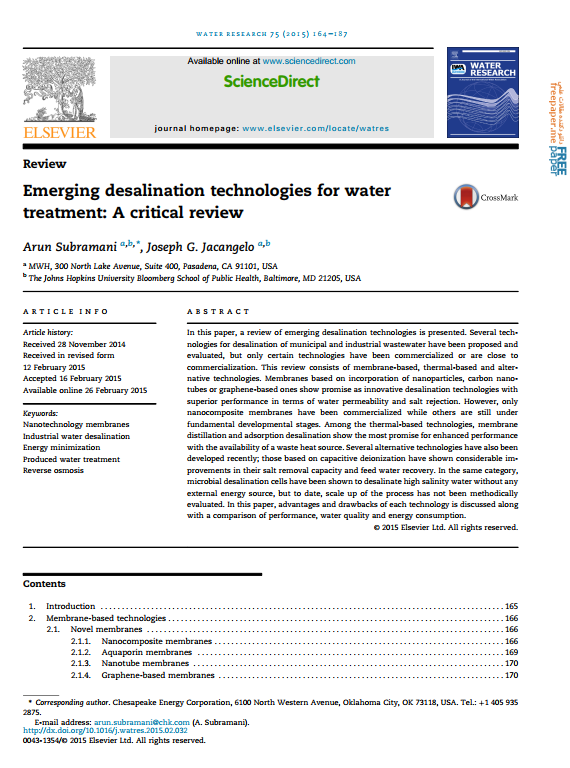
Reviews
There are no reviews yet.